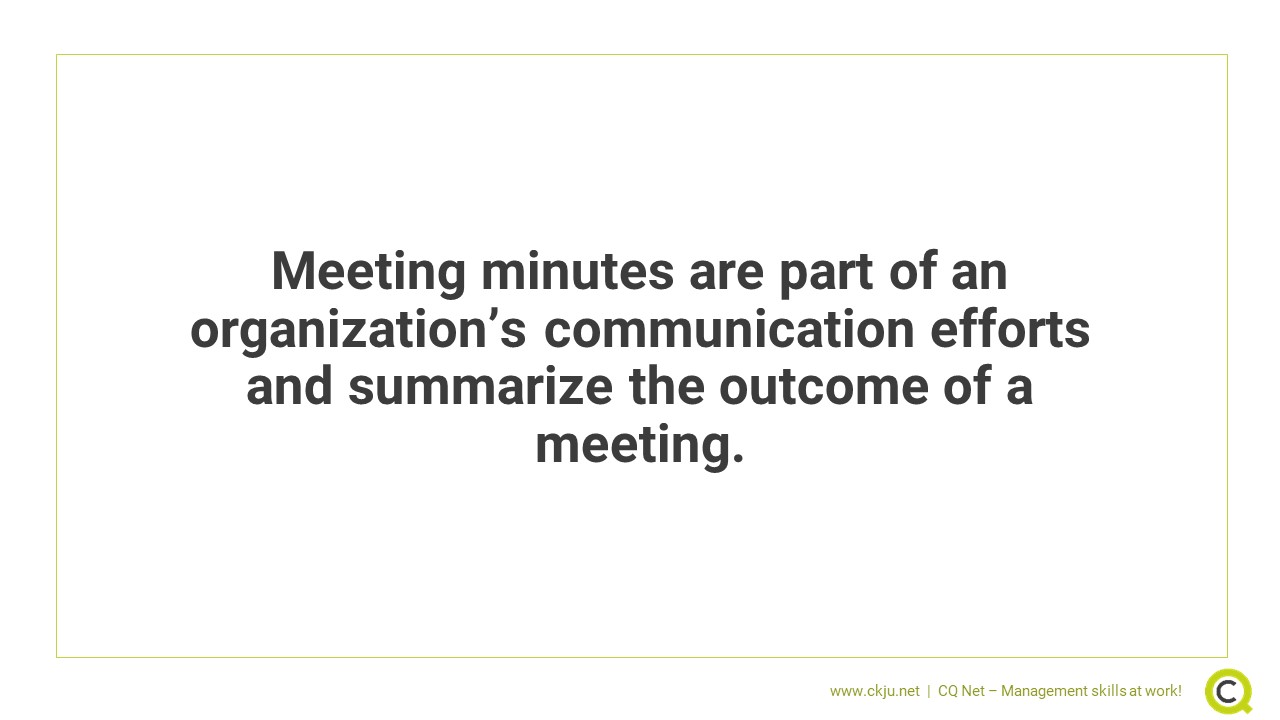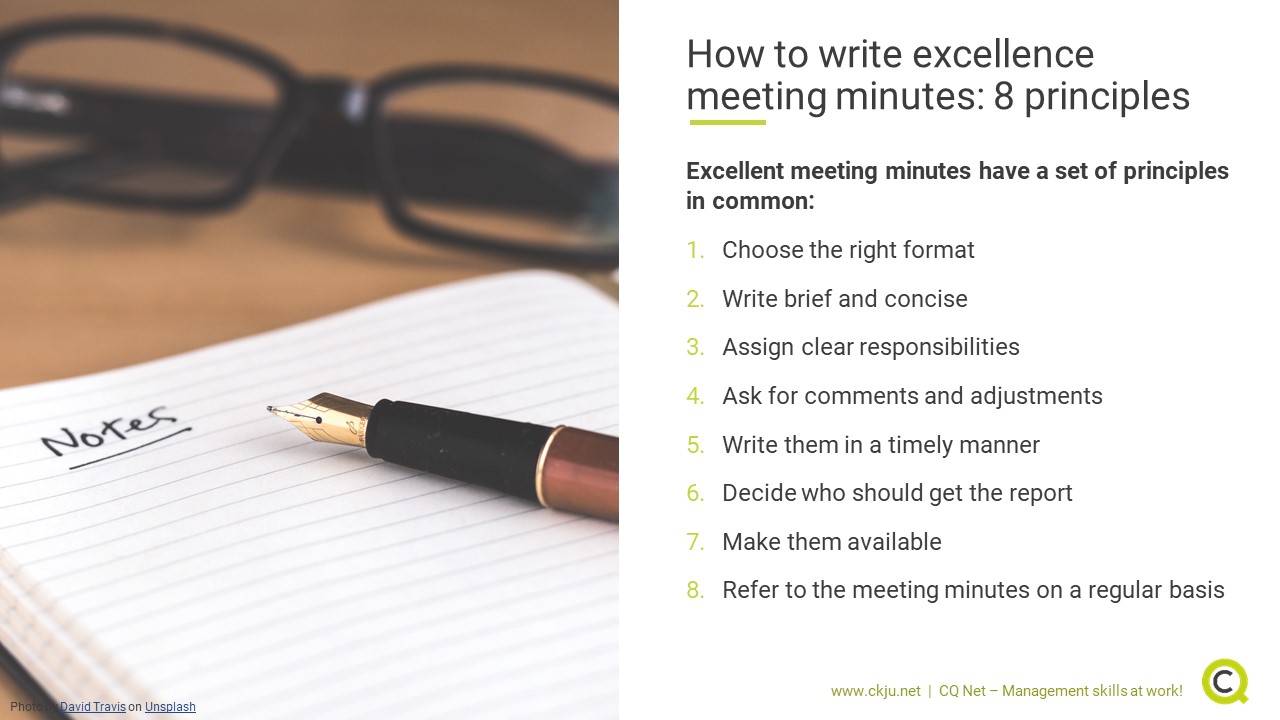- All Management Learning Resources
- Meeting Minutes

Why should you care about meeting minutes?
Communication is the lifeblood of an organization. As a professional, you will host and moderate meetings, video conferences and other means of communication in your organization. Meeting minutes are an important building block of an effective communication approach. Consequently, you need to know why meeting minutes are important and how to create them in the most effective and efficient way.
Contents
What are meeting minutes?
There are many work-related reasons to meet other people in an organization. Examples include problem-solving activities, the need for information exchange or formally required gatherings such as supervisory board meetings.
In total, the time spend in meetings represents a considerable portion of all communication efforts taking place in an organization. An important measure whether this time is spent well is the quality of those meetings. One important factor that determines a meeting’s quality is its documentation (Wolfe, 2006).
Meeting minutes are part of an organization's communication efforts and summarize the outcome of a meeting. This includes the following three main content elements (Neville and Re, 2019):
- The reason why the meeting took place and its objective (framing)
- The decisions taken und key messages agreed-upon and,
- The measures and tasks defined.
The way meeting minutes are prepared varies depending on the type of the meeting, the team involved and the organization’s communication approach. However, meetings minutes have one thing in common: They are some sort of digital or physical written document.
How do meeting minutes work?
There is no-one-size-fits-all way to write meeting minutes. In some cases, there are formal requirements (e.g. legal requirements for stock listed companies, NGOs) you need to keep in mind. However, in most cases it is up to you how to decide where to put your focus.
From an organizational performance point of view, the main objective of meeting minutes is to summarize the outcome of a meeting (Drucker, 1967). This requires you to focus on the following three main content elements.
The reason why the meeting took place and its objective (framing)
The first element you need to consider is the reason why the meeting took place and its objective. You are basically putting a frame around the meeting so that people understand its context and the bigger picture.
This makes it much easier to recognize the added value of the meeting and to put the results into perspective. In addition, it allows people who did not participate in the meeting but need to know the meeting results to better understand its background.
The decisions taken und key messages agreed upon
The second content element important for your meeting minutes are the decision taken and the key messages agreed-upon. From a change management perspective, decisions and key messages are important narratives to make change happen. They initiate, shape, or change your organization’s social reality once people accept them (McEachern, 1998).
In order to summarize the most important decisions and key messages in a way such that people accept them, it is important for you to identify them during the meeting. As a meeting moderator or facilitator, you can summarize the decisions and key messages already during the meeting and ask for confirmation.
The measures and tasks defined
The third and last content element you should focus at are measures and tasks formulated in the meeting. Most professionals determine whether a meeting was successful by looking at whether all measures and tasks are documented and subsequently completed in time and in the right quality.
This makes it important for you not just to document the measures and tasks, but also the desired outcome associated with them. For instance, when the task is to conduct a follow-up meeting, the outcome could refer to the meeting was conducted, or the meeting invitation was sent to the participants.
How to write excellence meeting minutes?
Excellent meeting minutes have a set of principles in common even. This does not mean that they look similar or use the same format. Instead, they are created having the following guiding principles in mind.
Choose the right format
Meeting minutes summarize the outcome of a meeting. Depending on the type of the meeting, the format you use to prepare them can vary. For instance, a brief online call with a co-worker doesn't require a formal meeting report but could be summarized in an e-mail (Gimenez, 2006). A formal supervisory board meeting requires you to use a pre-defined template in line with legal and company requirements.
Write brief and concise
Excellent meeting minutes have a clear emphasis on decisions taken, key messages agreed-upon and measures defined. This requires you to boil the meeting outcome down to the main results and document them in a concise way.
Assign clear responsibilities
Attention and even more activity are scares resources in organizations. This makes it important to assign clear responsibilities to the measures and tasks documented in your meeting minutes. In case more than one person is needed to get a task done, assign one person who is in the lead and supported by the other ones mentioned as well.
Ask for comments and adjustments
Keep in mind that the meeting minutes reflect the way you understand the meeting outcome. This doesn't necessarily have to be the same understanding the other meeting participants have. To make sure all participants are on the same page, ask for comments and if required adjustments before distributing the final version.
Write them in a timely manner
Meetings usually take place because there is something that needs to be clarified, aligned, or decided in a timely manner. Wouldn't the topic be time critical, there is no need for a meeting. The same applies to meeting minutes. Write them in a timely manner as long as the key take-aways are still fresh and you remember them.
Decide who should get the report
Depending on the type and objective of the meeting, it could make sense to inform people who didn't participate in the meeting about its outcome as well. This important decision is up to you and can have an important impact how things evolve.
Make them available
There is nothing more annoying than distributing meeting minutes attached to an e-mail. People struggle to find them once the need them at a later point in time. Make them available in a shared folder, team communication platform or shared drive instead.
Refer to the meeting minutes on a regular basis
Meeting minutes can help you to drive change, communicate important key messages and follow-up on agreed-upon measures and tasks. This requires you to refer to them on a regular basis such as during a follow-up meetings or other occasion of verbal communication.
What are the benefits of meeting minutes?
Meeting minutes are an important building block of an organization’s comrmunication approach. The key benefits associated with meeting minutes are as follows:
- Meeting outcomes are documented and thus available after the meeting
- Accountability in terms of measures and tasks defined is supported
- Change efforts are directed towards the key messages documented in the summary
- Individual and organizational learning is supported by sharing the meeting outcome
- A common understanding of important messages also referred to as team mental model is generated
What are the shortcomings of meeting minutes?
There are no real shortcomings associated with meeting minutes. There are just one issue somehow connected to meeting minutes worth mentioning:
Writing meeting minutes to compensate for a dysfunctional organization culture
Some organizations with a dysfunctional organizational culture and a lack of psychological safety put a lot of pressure on their people to avoid making mistakes. In such an environment people avoid being connected to any topic that could have a negative impact on the organization and thus backfire on them.
Driven by fear, people tend to document everything that could help them to stay out of harm’s way when things go awry. This could lead to a sudden rise of people writing meeting minutes as part of their efforts to stay out of trouble.
Key recommendations for professionals
- Meeting minutes are an important building block of an effective communication approach
- You need to know why meeting minutes are important and how to write them
- Meeting minutes cover three main content items: Meeting context and objective, key messages, measures, and tasks
- Eight guiding principles can help you to write excellent meeting minutes
- Meeting minutes are associated with a set of benefits such as organizational learning and increasing accountability
References and further reading
Drucker, P. F. (1967) The effective executive: The definitive guide to getting the right things done, New York, NY, Harper Business.
Gimenez, J. (2006) ‘Embedded business emails: Meeting new demands in international business communication’, English for Specific Purposes, vol. 25, no. 2, pp. 154–172.
McEACHERN, R. W. (1998) ‘Meeting Minutes as Symbolic Action’, Journal of Business and Technical Communication, vol. 12, no. 2, pp. 198–216.
Neville, K. and Re, S. (2019) ‘Guidelines for Creating Meaningful Meeting Minutes’, Teaching and Learning in Nursing, vol. 14, no. 4, pp. 235–237.
Wolfe J. (2006) ‘Meeting Minutes as a Rhetorical Genre: Discrepancies Between Professional Writing Textbooks and Workplace Practice Tutorial’, in IEEE Transactions on Professional Communication, vol. 49, no. 4, pp. 354-364, Dec. 2006, doi: 10.1109/TPC.2006.885837.
About the Author




